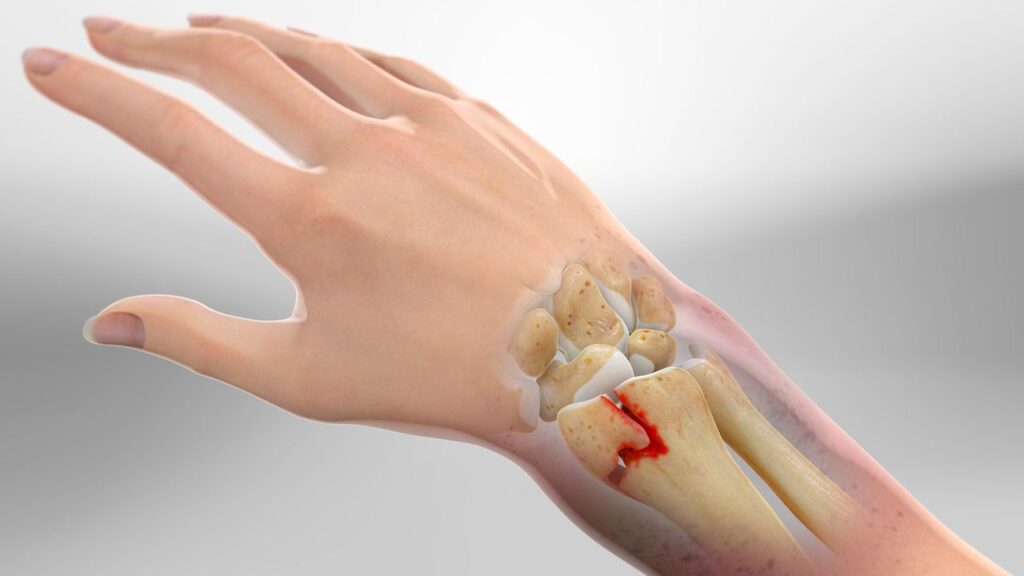Wrist fracture
Wrist fractures are breaks in one or more of the bones in the wrist, most commonly the radius. These injuries often occur due to falls, sports injuries, or accidents.
At a glance
About
A fractured wrist can result in severe pain, swelling, bruising, and difficulty moving the hand or wrist.
Effective
Referrals
Not Needed
Booking
Instant-book option available
Cost
-
Lincolnshire £ 9000
Nature of wrist fracture treatment
Wrist fracture treatment may be non-surgical or surgical, depending on the severity of the break. Stable fractures are often treated with immobilisation using a cast or splint to allow the bones to heal naturally. More severe or displaced fractures may require surgical intervention using pins, screws, or plates to realign and stabilise the bones.
Common causes of wrist fractures
Wrist fractures usually occur due to direct trauma or falls, including:
Falls onto an outstretched hand: One of the most common causes, particularly during sports or slippery conditions.
Contact sports or accidents: High-impact collisions or crashes can place extreme force on the wrist.
Osteoporosis: Weakened bones increase the likelihood of fractures from low-impact trauma.
Repetitive stress injuries: Repeated strain can lead to hairline fractures, particularly in athletes.
Occupational hazards: Jobs involving heavy lifting or machinery can increase the risk of trauma to the wrist.
Diagnosing suitability for wrist fracture treatment
Diagnosis begins with a physical examination to assess pain, deformity, and movement restriction. Patients often present with immediate swelling, tenderness, and difficulty moving the wrist. X-rays are typically used to confirm the type and extent of the fracture.
In complex cases, a CT or MRI scan may be required to evaluate bone fragments or associated ligament damage. Once the severity is confirmed, a tailored treatment plan is developed to ensure proper healing and restore function.
Suitable for
Distal radius fracture

Scaphoid fracture

Treatment overview
Wrist fracture treatment focuses on restoring alignment, stability, and function to the injured wrist. For simple fractures, a non-surgical approach using a cast or splint may be sufficient, allowing the bones to heal naturally over several weeks. In more complex or displaced fractures, surgical intervention may be required to realign the bones and secure them with plates, screws, or pins. The choice of treatment depends on the type, location, and severity of the fracture. Rehabilitation is often necessary after immobilisation or surgery to regain strength, flexibility, and full range of motion in the wrist.
- Non-surgical approach: Minor fractures are treated with immobilisation using a cast or brace for several weeks.
- Surgical treatment: More complex fractures may require internal fixation using metal plates or pins to maintain alignment during healing.

Benefits

Restores wrist stability and alignment

Reduces pain and swelling

Promotes proper bone healing

Prevents long-term complications

Tailored surgical or non-surgical options
How to Pay
We offer a range of flexible payment options to make your treatment experience smooth and stress-free.
Paying for Yourself (Preferred Option)
Most patients choose to self-fund their treatment. We accept:
- Bank Transfers
- Credit/Debit Cards
- Cash (in person only)
Instalment Plans
We’ve partnered with GoCardless to offer interest-free instalment options. You can easily set up a Direct Debit to spread the cost of your treatment over time.
Finance Options
Looking for a financing plan? You can apply through Kandoo, our trusted finance partner.
- Instant online decision
- No impact on your credit score
- Multiple lenders for competitive rates
Private Medical Insurance (Limited Availability)
We work with a small number of approved insurance providers. However, due to restrictions from many insurers, not all treatments are covered. Please check with your insurer and speak to our team before booking to avoid disappointment.
The booking process
Online booking/call
Use our Calendly to book an initial consultation, or give us a call.
01
consultation
If you are a new patient, our doctors might arrange a consultation before treatment.
02
Treatment
You will be booked in for treatment.
03
Follow up
Our doctors might arrange a follow-up consultation, to check your response to treatment.
04
Discharge
Once your doctor is happy with your recovery, you will be discharged. After discharge, we are always here for further questions or support, should you need it.
05
Frequently Asked Questions
What are the symptoms of a wrist fracture?
Common symptoms include sudden wrist pain, swelling, bruising, and visible deformity. Patients may also struggle to move or grip with the hand.
How long does recovery take after wrist fracture treatment?
Recovery varies based on the severity of the fracture. Minor fractures may heal in 6–8 weeks, while complex cases requiring surgery may take several months with physiotherapy.
Is surgery always required for wrist fractures?
Not always. If the fracture is treated within two weeks and the bone is in the right position, surgery may not be needed. But if it’s delayed, it can be harder to fix — and sometimes the bone has to be re-broken to set it properly.
Schedule A Discovery Call With Us
Don’t wait to find relief. Whether it’s a consultation, scan, or treatment, we’re ready to help.






